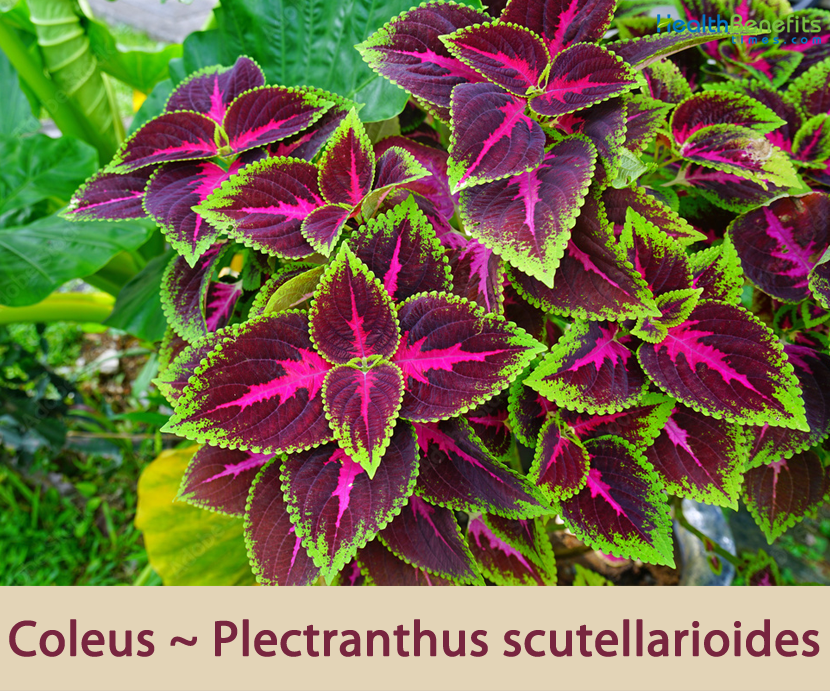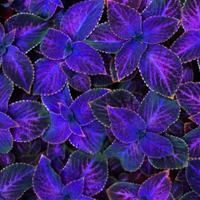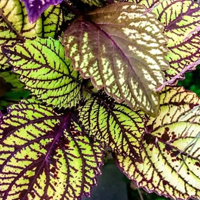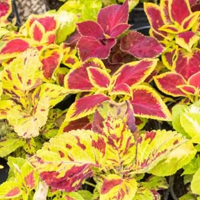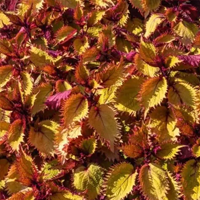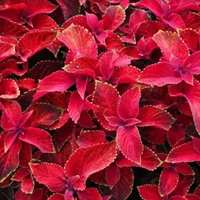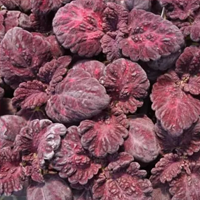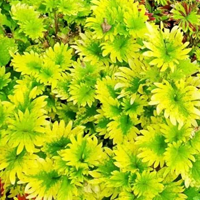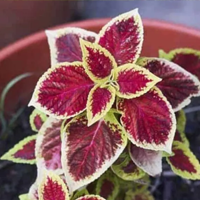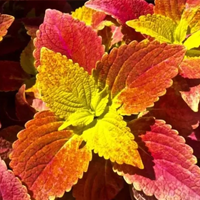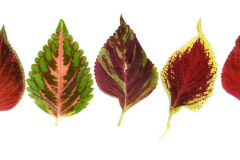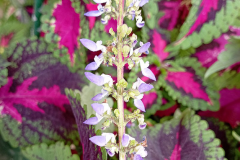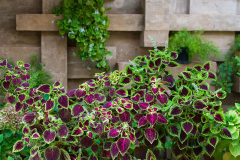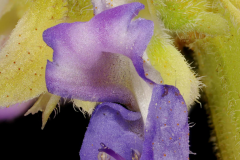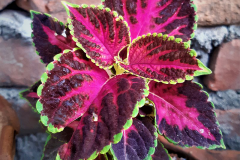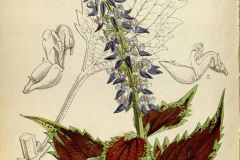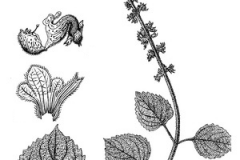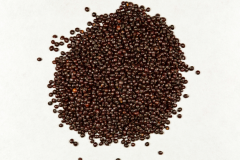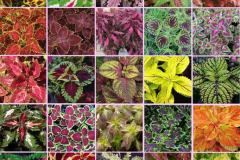The synonyms Coleus blumei, Coleus scutellarioides and Solenostemon scutellarioides are also widely used for this species. Genus name Plectranthus is derived from the Greek words plectron meaning spur and anthos meaning flower in reference to the spur-shaped flowers of some members of the genus. Specific epithet scutellarioides means resembling the genus Scutellaria which comes from the Latin word scutella meaning a small dish or saucer in reference to the shape of the persistent calyx after the flowers fade.
Coleus Facts
| Coleus Quick Facts | |
|---|---|
| Name: | Coleus |
| Scientific Name: | Plectranthus scutellarioides |
| Origin | Continental southeast Asia southward to Malesia and northern Australia |
| Colors | Initially green turning to brown to black |
| Shapes | Nutlets that are lenticular to broadly ovate or orbicular, about 1 - 1.2 mm long |
| Health benefits | Support for headaches, fever, dyspepsia, ophthalmia, conjunctivitis, asthma, angina, bronchitis, epilepsy, insomnia, skin rashes, digestive problems, elephantiasis, amenorrhea, earache, diabetes and constipation |
| Name | Coleus |
|---|---|
| Scientific Name | Plectranthus scutellarioides |
| Native | Continental southeast Asia southward to Malesia and northern Australia (the Bismarck Archipelago, Borneo, Cambodia, Southeast China, Java, Laos, the Lesser Sunda Islands, Peninsular Malaysia, Maluku, Myanmar, Nansei-shoto, New Guinea, Northern Territory, Philippines, Queensland, the Solomon Islands, Sulawesi, Sumatra, Taiwan, Thailand, Vietnam, and Western Australia). |
| Common Names | Coleus, Painted-nettle, Common coleus, painted-leaf plant, variegated coleus, Flame Nettle |
| Name in Other Languages | Afrikaans: Coleus Albanian: Coleus Amharic: Kolēwosi (ኮሌዎስ) Arabic: Alqawlius (القوليوس), nabat alsajaad (نبات السجاد) Armenian: Coleus (kōlēəs) Azerbaijani: Coleus Bengali: Coleus (kōlēəs) Bulgarian: Koprivka (копривка), dekorativna koprivka (декоративна копривка) Burmese: Coleus (kōlēəs) Caribbean: Jacob’s coat Chinese: Jǐn zǐ sū (锦紫苏), Wu cai su (五彩苏), xiao wu cai suyuan bian zhong, Cǎi yè cǎo (彩葉草) Chuukese: Karamat Cook Islands: Televete, terevete Croatian: Coleus Cuba: Manto, orégano francés Czech: Coleus, pochvatec šišákovitý Danish: Coleus Dominican Republic: Tocador Dutch: Coleus, Siernetel English: Coleus, Painted-nettle, Common coleus, painted-leaf plant, variegated coleus, Flame Nettle Esperanto: Coleus Estonian: Coleus Fijian: Lata, lau lata Filipino: Coleus Finnish: Coleus, Isokirjopeippi, värinokkonen French: Coleus, terevete, coléus scutellaire, plectranthe fausse-scutellaire Georgian: Koleusi (კოლეუსი) German: Coleus, Buntblatt, Buntnessel, Coleus-Blumei-Hybriden Greek: Coleus (kōlēəs), oraiófyllo (ωραιόφυλο) Gujarati: Kōliyasa (કોલિયસ) Haiti: Manteau de St. Joseph Hausa: Coleus Hawaiian: Weleweka Hebrew: קולוס Hindi: Coleus (kōlēəs) Hungarian: Coleus Icelandic: Coleus, Álfamöttull Indonesian: Coleus, Daun iler, Miana, Ati-ati, Jawer kotok, kentangan, adang-adang, Iler Irish: Coleus Italian: Coleus, Solenostemon scutellaroides Jamaica: Joseph’s coat, painted nettle Japanese: Koriusu (コリウス), niwajiku, saya-bana, kinranjiso, nishikijiso (ニシキジソ), Kinranjiso (キンランジソ) Javanese: Coleus Kannada: Kōliyas (ಕೋಲಿಯಸ್) Kazakh: Kolieus (колеус ) Korean: Daejang-gyun (대장균) Kurdish: Coleus Kwara‘ae: Asaka Lao: Coleus (kōlēəs) Latin: Coleus, Solenostemon scutellaroides Latvian: Coleus Lithuanian: Coleus Macedonian: Coleus (kōlēəs), sharena kopriva (шарена коприва) Malagasy: Coleus Malay: Coleus, ati ati, Pokok Ati-ati Merah Malaysia: Kentongan, daun ati-ati, ati-ati merah, ati-ati besar Malayalam: Kēāliyas (കോലിയസ്), tiruhr̥dayacceṭi (തിരുഹൃദയച്ചെടി) Maltese: Coleus Maori (Cook Islands): Televete, terevete Marathi: Koliyas (कोलियस) Micronesia, Federated states of: Karamat, koaramahd, koionleng, koramahd, koromaht, waruguchá Minangkabau: Piladang (tumbuahan) Mongolian: Coleus (kōlēəs) Nepali: Xkoliyas (ਕੋਲੀਅਸ) New Zealand: Pate Niue: Selevese, televete Norwegian: Coleus Oriya: କୋଲେସ୍ Papua New Guinea: Jangata, jeune , okavu Pashto: کولیس Persian: کولئوس Philippines: Dapoyana, lapunaya, malamayana, patak dugo, saimayu, taponaya, badiara, malaina, mayana Pohnpeian: Koaramahd, koionleng, koramahd, koromaht Polish: Coleus, koleus Blumego, koleus, pokrzywka brazylijska Portuguese: Coleus, Coração-magoado, coleo Puerto Rico: Coleo, nazareno, tocador, verguenza Pukapukan: Televete Punjabi: Kōlī asa (ਕੋਲੀਅਸ) Romanian: Coleus, poala maicii precista Russian: Koleus (Колеус), Kolieus Bliuma (Колеус Блюма) Samoa: Fateine, la‘au fai sei, pate Satawalese: Waruguchá Serbian: Coleus (Цолеус) Sindhi: ڪليس Sinhala: Coleus (kōlēəs) Slovenian: Koleus Solomon Islands: Asaka Spanish: Coleo, Ahijado, Nene, Macho, Nene, Solenostemon scutellaroides Sundanese: Coleus Swedish: Coleus, Palettblad Tajik: Coleus (kōlēəs) Tahitian: Terevete Taiwan: Cǎi yè cǎo (彩葉草) Tamil: Kōliyas (கோலியஸ்) Telugu: Coleus (kōlēəs) Thai: Coleus (kōlēəs), ruese phasom laeo, waan lueat haeng Tokelauan: Pate Turkish: Coleus Ukrainian: Koleus (колеус) Urdu: کولیس USA/Hawaii: Weleweka Uzbek: Koleus Vietnamese: Coleus, tiá tô tây Welsh: Coleus Zulu: Coleus |
| Plant Growth Habit | Erect, bushy, branched, woody-based, upright annual or short-lived evergreen perennial plant |
| Growing Climates | Monsoon forest, beach forest, in disturbed areas, mesic to wet forest, stream sides, open areas, hills, fields and forests |
| Soil | Grows in moist, organically rich, loose soils in part shade, although it can tolerate full shade and some recently developed cultivars can tolerate full sun |
| Plant Size | Usually 0.5–1 m (1.6–3.3 ft) tall, though some may grow as tall as 2 m (6.6 ft) |
| Root | The plants has fibrous roots. |
| Stem | Herbaceous shrub turns to semi-woody at base when mature. Stems erect or ascending, the branchlets finely pubescent to glabrous |
| Leaf | Somewhat fleshy, varying in size from 1.5–10 cm (0.6–3.9 in) long and 1–6 cm (0.4–2.4 in) wide, generally ovate in shape, and borne on petioles (stalks) from 0.5–5 cm (0.2–2.0 in) long |
| Flowering season | June to October |
| Flower | Purplish, numerous, and borne in lax, terminal, simple or branched inflorescences, 15 to 30 centimeters long. Calyx is green, and about 2.5 millimeters long, with the upper lip ovate and the lateral lobes short and ovate, the lower one being 2-cleft. Corolla is about 11 millimeters long. |
| Fruit Shape & Size | Nutlets that are lenticular to broadly ovate or orbicular, about 1 – 1.2 mm long |
| Fruit Color | Initially green turning to brown to black |
| Propagation | By seeds or stem cuttings |
| Plant Parts Used | Leaves, seeds, bark |
|
Kiwi Fern Fishnet Stockings Wizard Mix Henna Trailing Plum Black Dragon Limelight Salmon Pink Big Red Judy Rustic Orange |
| Health benefits |
|
Plant Description
Coleus is an erect, bushy, branched, woody-based, upright annual or short-lived evergreen perennial plant that normally grows about 0.5–1 m (1.6–3.3 ft) tall, though some may grow as tall as 2 m (6.6 ft). It is widely grown for the highly decorative variegated leaves found in cultivated varieties. The plants have fibrous roots. Herbaceous shrub turns to semi-woody at base when mature. Stems are erect or ascending, the branchlets finely pubescent to glabrous. The plant is found growing in monsoon forest, beach forest, in disturbed areas, mesic to wet forest, stream sides, open areas, hills, fields and forests. The plant grows in moist, organically rich, loose soils in part shade; although it can tolerate full shade and some recently developed cultivars can tolerate full sun. It has been assiduously hybridized over the years into a very large number of vegetatively propagated and seed propagated strains with an almost infinite number of leaf color combinations including most colors of the spectrum except true blue.
Leaves
The species is extremely variable in the color and shape of the leaves. Foliage color ranges from yellow to red and dark purple. They are somewhat fleshy, varying in size from 1.5–10 cm (0.6–3.9 in) long and 1–6 cm (0.4–2.4 in) wide, generally ovate in shape, and borne on petioles (stalks) from 0.5–5 cm (0.2–2.0 in) long. The leaf margin is divided to a variable degree. Hairs are present on both sides of the leaf. The leaves are extremely soft and generally have a typical nettle shape; however, some varieties also have deviating leaf shapes.
Flower
The inflorescence is borne on the end of a stem and, like the leaves, is very variable in size. It may be up to 4 cm (1.6 in) long, with few or many flowers. The calyx is bell-shaped, initially only 1–2 mm (0.04–0.08 in) long, but lengthening to 5–7 mm (0.2–0.3 in) when in fruit. The bluish-purple petals are joined to form a typical two-lipped labiate flower, 8–10 mm (0.3–0.4 in) long. The stamens are joined for about half their length and are covered by the upper lip of the flower. Flowering normally takes place in between June to October.
Fruit
Fertile flowers are followed by nutlets that are lenticular to broadly ovate or orbicular, about 1 – 1.2 mm long. They are brown to black, shining, minutely tuberculate, and mucilaginous when wet.
History of Introduction and Spread
P. scutellarioides is considered native to Southeast Asia, New Guinea and northern Australia. It was introduced to other parts of Asia including the Philippines, the Marshall Islands, and various parts of Asia-Pacific, as well as to the New World for cultivation as a medicinal, ornamental and culinary plant, and is now pan-tropical. Date of the species’ introduction to the West Indies is uncertain but it may have occurred around the turn of the twentieth century. It was not included in Bello’s flora of Puerto Rico but was present in the Antilles by 1911, as it was included in volume 4 of Ignatiuz Urban’s work on the Antilles. It was in Puerto Rico by 1924, and various Coleus species were reportedly being cultivated as ornamentals in Bermuda by 1918 for their variegated leaves. In Asia-Pacific, P. scutellarioides was introduced to the Philippines by 1923 and is a more recent introduction to the Marshall Islands, where it is still considered a rare species.
Types of Coleus Plant
There are many different types of Coleus plants. Some of the most popular ones are discussed below.
1. Kiwi Fern
This cultivar grows up to a height of 12 to 24 inches. It blooms very heavily and very quickly. The flower colors of this cultivar are baby blue and purple and it attracts hummingbirds. The species name for this plant is Plectranthus scutellarioides. Part sun or high shade is ideal for the growth of this variety.
2. Fishnet Stockings
This variety can grow up to a height of 3 feet and is characterized by upright growth. It does not grow very wide. Part shade is ideal for the growth of this cultivar. Spring and summer are the blooming seasons for this plant. The leaves are of striking green color and have slight burgundy variations.
3. Wizard Mix
This cultivar is a colorful variation of coleus. It has many different colors and they all come as a surprise. This cultivar is 10 inches tall and can spread 10 to 14 inches wide. These grow very fast and seeding should ideally be started indoors. Part sun or full shade, both are ideal for the growth of this plant. This annual plant has ornamental uses like it can be used in beds and containers.
4. Henna
The scientific name for this cultivar is Solenostemon scutellarioides. It grows up to a height of 2 feet and is 2 feet wide. They have a burgundy color and are slightly golden towards the center. These give shades of copper from afar. These plants are upright and mounded and are relatively low-maintenance plants. These plants can tolerate heat well.
5. Trailing Plum
The scientific name for this cultivar is Plectranthus scutellarioides. This is a low-growing cultivar and thrives in the sun. The foliage color is a striking red with the margins of crimson color. The edges are green in color. It is good for borders, beds, and window boxes. These are annual plants and should be grown in places that are frost-free. Partial shade or partial sun is ideal for their growth.
6. Black Dragon
This cultivar grows to a height of 12 inches and is relatively smaller in size compared to the rest of the Coleus plants. The seeds for this plant should be sown around 10 to 12 weeks before the last spring frost. Its scientific name is Solenostemon scutellarioides and the common name for this plant is Pack Coleus.
7. Limelight
This plant grows up to a height of 12 to 16 inches. The leaves are neon-colored and glow in shady spots or containers. These lime green leaves look very lovely when paired with purple flowers. This cultivar is easy to grow and grows very well in shaded borders. The largest leaf of this cultivar can grow up to 8.5 inches long and can be 6 inches wide.
8. Salmon Pink
This plant grows up to a height of 30 inches and is just as wide. This annual plant has pointy leaves that are light green and have pinkish veins. The leaves are larger than the rest of the cultivars. This is a low-maintenance plant and the flowers can be pinched off as they appear. It can be used very well for border edging and general garden use. This plant cannot tolerate frost and grows very fast if the conditions are ideal.
9. Big Red Judy
This cultivar is a 30 to 48-inch tall plant that glows. The scientific name for this cultivar is Solenostemon scuttelarriodes. This is an annual plant that is grown for its large upright leaves. The leaves are of a rust color with a tinge of gold. It needs to be watered twice a week for the first six weeks and then it should be watered weekly, especially in the dry weather. This does not need fertilizer.
10. Rustic Orange
The species name for this cultivar is Plectranthus scutellarioides. A warm temperature is ideal for the growth of this plant. This perennial cannot tolerate frost. The coleus leaves of this cultivar are orange in color with yellow edges. They have a bushy growth and need good air circulation for healthy growth.
Health benefits of Coleus
Listed below are some of the popular health benefits of Coleus
1. For Menstruation
Coleus (Mayana) leaf is a good natural solution for menstruation disorders or irregular menstruation. It can help improve and correct your menstrual cycle. Try this natural solution by boiling Mayana leaves, and then allow to cool and drink.
2. Relieve and Cure Fever
It has a very good property that helps relieve and cure fever. Coleus (Mayana) plant will help to heal and lower fever heat naturally. Make this solution by taking the stems and leaves. Boil it and allow it cool. Drink a half glass daily.
3. Treat Hemorrhoids
It can help treat hemorrhoids. Hemorrhoid is a kind of health problems that often arise because the conditions are not realized. Take some Coleus (mayana leaves) and also turmeric, wipe and then boiled by some cups of water. Allow to cool and drink one glass each day.
4. Relieve Cough
Coleus (Mayana) plant can be used to help cure and relieve symptoms of a cough. It has extremely good properties and helps remove phlegm attached to the throat, so it is very effective to help relieve cough symptoms double experienced.
5. Treat Diabetes
Coleus (Mayana) plant is helpful in treating diabetes. For those who may have diabetes, the leaf of mayana plant is useful for you. To process it, boil the stems, leaves, and flowers of the plant. After that, you simply drink the decoction on a regular basis to help lower your blood sugar levels
6. Relieves Headaches
If you’re suffering from a headache, you can use Coleus (mayana) leaves to treat it. You can pound the leaves until the juice extracts are released. You can perhaps use a juicer or a powerful blender too. You then wipe or massage it on the affected part of your head.
7. Helps Treat Boils
Coleus (Mayana) has been used to treat boils for centuries. You need to heat mayana leaves but not to the extent of burning it. Then place the leaves on the affected parts of your body.
8. Heals Bruises and Swelling
It’s been said that using Coleus (mayana) leaves can speed up the process the healing of bruises and lessen swelling. Just like treating your headache, you just need to get the juice extracts of the mayana leaves and then spread them to the affected part.
9. Relieves Symptoms of Cough
If you’re having problems with cough, drinking the liquid after boiling Coleus (mayana) leaves can help you. It has qualities that are able to remove the phlegm from your respiratory tract.
10. Cures Digestive Disorders
Consuming Coleus (mayana) can help you with some digestive disorders. It can help relieve stomach pains and heartburns. It may also help with enteritis.
Traditional uses and benefits of Coleus
- In the Philippines, pounded leaves used as a cure for headaches, applied to the temples or nape of the neck.
- It is also used for healing bruises.
- It is also used by the Ati tribe in Malay, Aklan for fever and headaches.
- Decoction is taken internally for dyspepsia and for wasting away.
- Decoction is used as eye drops for ophthalmia and conjunctivitis.
- Reported use in Asian traditional medicine for asthma, angina, bronchitis, epilepsy, insomnia, skin rashes and various digestive problems.
- In India, fresh juice of leaf and stem is mixed with the juice of raw citrus fruits and applied over the skin during scorpion bite.
- In Samoa, it is used to treat elephantiasis.
- In Southeast Asia, it is used to treat dysentery and various digestive problems.
- In Vanuatu, leaves are used for abortion; also for amenorrhea.
- Sap is used as contraceptive and whole plant leaves used as emmenagogue.
- Leaves are also used to facilitate lactation by heating or softening flowers in hot water and applying the preparation on the nipples.
- In Fiji, it is used to treat diarrhea; juice of leaves are used to treat earache.
- In Thailand to Malaya, pulped leafy stems or decoction is used to stimulate digestion, used to relieve pain ascribed to the heart, congestion of the liver with swollen hands and feet.
- Leaf paste is occasionally applied over the stomach, heart and glandular swellings.
- Decoction is used internally for dyspepsia and wasting.
- It is also used for hemorrhoids and to regulate menstruation.
- It was once used to prevent conception.
- Roots are used for colic and diarrhea.
- In Indonesia, the color blaze dark star variety is used fresh, boiled, or infused to treat blain, abscesses, ulcers, and eye and ear inflammation.
- Roots are used for diarrhea and stomach pains; also for diabetes, constipation, fever, and dysmenorrhea.
- Ethnic Toraja use leaves to treat pulmonary tuberculosis.
- In Southeast Asia it is considered a medicinal plant and used to treat wound infections.
- Roots are used internally in the Moluccas to treat diarrhea and colic.
- Leaves as anthelmintic and to treat urinary complaints.
- Sap is squeezed into the eye in the case of eye injury, and rubbed on swellings.
- In Indonesia the sap or a decoction is used as an abortivum and emmenagogue, and to treat hemorrhoids, inflamed eyes and boils.
- In Malaysia, a decoction of the leaves is used to stimulate digestion, as a sedative, to treat dyspepsia and congestion of the liver, and externally against swellings and smallpox.
- Fresh leaves are applied in the Philippines externally or in cataplasm to bruises and contusions, and to treat headache.
- In Papua New Guinea, young leaves are baked and squeezed whilst hot onto fresh cuts and sores.
- It has also been used to help improve breathing impaired by conditions like asthma or bronchitis.
- It has also been used to treat skin wounds, rashes and other conditions like eczema.
Ayurvedic Health benefits of Coleus
- Mild bleeding of wounds: Wash the young leaves; crush and extract the juice. Drop a few drops of the juice directly on the wound. Apply the crushed leaves as poultice.
- Sinusitis: Heat 10-12 fresh leaves over a fire. Apply while still hot over the forehead for the frontal sinuses or over the cheeks for the maxillary sinuses, twice daily.
- Dyspepsia: Decoction, taken internally.
- For bruises and sprains: 10-12 leaves are crushed or pounded and applied over the ankles, wrists or affected areas for 30 minutes, three times daily, the poultice held in place by a bandage.
- Cough: Put fresh, clean leaves into a pitcher of water and use as drinking water every day.
- Headache: Use a mortar and pestle and pound the leaves and extract its juice. Gently wipe the juice to the affected area to provide a cooling effect to the head and relieve a headache.
- Bruises and Swelling: Gently press the leaves to reveal a small amount of juice and put it on top of the bruised or swollen area.
- Anti-inflammatory: Use the same process as you did with the cough remedy. Take the Mayana infusion as a substitute for your water daily.
Other Facts
- Sap from leaves of the wild, purple-black species is used in tattooing.
- Reported toxicity to dogs from ingestion of leaves.
- In Papua New Guinea, it is used as a food additive.
- In Java, the species is used as a living fence in coffee plantations.
- scutellarioides is commonly cultivated for its ornamental purplish foliage.
- It tolerates long periods of heat; it is often grown as an annual.
- Coleus (coleus scutellarioides) is not toxic to cats or dogs.
Precautions
- The plant and sap can cause a reaction in sensitive people, resulting in minor skin irritation, and if eaten, this irritation may occur in the mouth and throat.
- They are toxic to pets, and if a dog or cat eats the plant it could cause symptoms such as diarrhea, vomiting, depression and loss of appetite.
References:
http://www.stuartxchange.com/Mayana.html
http://www.theplantlist.org/tpl1.1/record/kew-158489
https://en.wikipedia.org/wiki/Coleus_scutellarioides
https://indiabiodiversity.org/species/show/266274
https://www.cabidigitallibrary.org/doi/10.1079/cabicompendium.118545
https://www.nparks.gov.sg/florafaunaweb/flora/2/4/2460
https://www.missouribotanicalgarden.org/PlantFinder/PlantFinderDetails.aspx?kempercode=a547
https://uses.plantnet-project.org/en/Plectranthus_scutellarioides_(PROSEA)#Synonyms
https://apg.pir.sa.gov.au/gringlobal/taxon/taxonomydetail?id=317146
http://www.flowersofindia.net/catalog/slides/Coleus.html
https://gd.eppo.int/taxon/CXUBH
https://www.itis.gov/servlet/SingleRpt/SingleRpt?search_topic=TSN&search_value=519177#null
http://www.hear.org/pier/species/plectranthus_scutellarioides.htm
https://plants.usda.gov/home/plantProfile?symbol=SOSC7


